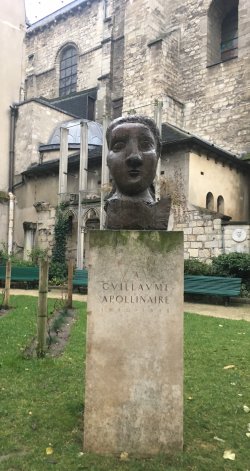COLLABORATIONS – Around Dora Maar – by Mary Ann Caws
Posted in: Guest Essay

I am looking at a head, marked “to Apollinaire, prince of poets,” and knowing it is in fact the likeness of one of Picasso’s mistresses, the photographer Dora Maar. So, let me think of this as a three-way collaboration: with Apollinaire, whose name figures here, Dora Maar, whose head figures here, and Picasso, whose art figures here.
This commemorative head is the substitution of a sometimes beloved mistress photographer for the always beloved poet whose head Picasso didn’t want to put here, as if he were — which he was, of course — dead. That was because that great artist had a phobia about death, and to have put the poet he so loved (indeed he did, even speaking to Apollinaire on his own death bed) into a memorial stone would have been both traumatic and terrible. Better confuse passersby into thinking the poet must have had a very feminine face, to have looked like that.
Patti Smith was once taken in by it, on her visiting to this square of Laurent Prache, behind the Eglise of St-Germain-des-prés when she was staying at that hallowed by the epochs Café de Flore, as described in her recent book Devotion.… I love writing about this in my just published Creative Gatherings: Meeting Places of Modernism, as if, in some impossible way, I could be community-gathering with these writers and artists and photographers.
And why not imagine a many-way meeting with those we love to read about and look along with and with whom we try to remember epochs. I love the history of the head: since Aristide Maillol had placed a patina on his statues by pissing upon them, Apollinaire had pissed upon one head of Dora Maar, turned it green, so this is the second head. And then, a few years ago, this head was stolen, and recovered alongside a Breton road, mysteriously. Everything about this head-spinning tale is mysterious.
Is not that, in fact, the most real of collaborative gatherings? The one we remember and re-dwell within? It is not a memorial but a memory, vivid beyond telling, better in the retelling, so I am considering a re-collaboration, heightened by its momentary nature.
Who didn’t love and love loving Picasso more than his mistresses, because we, the true appreciators of his art, don’t have to be involved with his infidelity. He is there for us always, permanently, however we look and care and judge his differing stages and carings: the genius perseveres. For me, that is the most true of workings-together, writing about what he painted about, seeing through his brush.
Because I love digressions, perhaps most of all, let me remind myself that Leonardo da Vinci, on whom I have just had the joy of writing for the Gagosian Quarterly, painted very often with his fingers instead of a brush, so endearing, like his mirror writing and his left-handedness. And so I come back to Dora Maar, around whom I am spinning this collaborative tale, who painted her rather awkward paintings — except for the landscapes around Ménerbes, which I love — with her left hand.
For me, collaboration is indeed about looking, through and with and around…so, “around Dora Maar” I have called this reflection on all this seeing together. I have spent my life collaborating with those I have written about and thought through, so, I hope, thought along with. So, perhaps more than a three-way collaboration, as I initially thought, here, I am celebrating a four-way collaboration, as best I can.
— Mary Ann Caws is Distinguished Professor Emerita and Resident Professor of Comparative Literature, English, and French at the Graduate School of the City University of New York. Her many areas of interest in twentieth-century avant-garde literature and art include Surrealism, poets René Char and André Breton, Virginia Woolf and the Bloomsbury group, and artists Robert Motherwell, Joseph Cornell, and Pablo Picasso.
